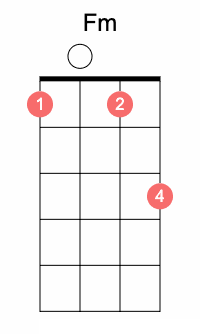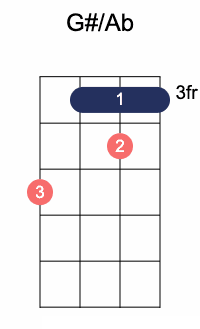The Fm ukulele chord might seem complicated to learn for a beginner, but it is definitely a great addition to your arsenal.
Written by Jay Searle / Published April 30, 2024
Last updated: April 30, 2024

The Fm chord on ukulele is a beautiful combination of notes that can be used in a wide variety of applications. It was used by many popular artists as the opening chord, most prominently in “All Of Me” by John Legend, but it’s equally great when used as the connecting tissue between other chords in bridges and pre-choruses.
Regardless of its complexity, it’s a vital uke chord that most players should know how to perform. We’re here with easy to follow Fm chord guides and diagrams to get you started, so let’s dive straight into it.
RELATED: Ukulele Chords for Beginners – A Quick and Easy Lesson
Notes in the Fm Ukulele Chord
The Fm ukulele chord is comprised of the notes F, Ab (or G#), and C. Note that Ab and G# are actually the same note sonically, just named differently. Don’t worry too much about ‘why’ for now (or we’ll be here forever discussing music theory!)
If you’ve already learnt how to play the F major chord, you may have noticed that there is only one note different in the F minor chord. The A note in the major chord has been moved down a semi-tone (or one fret) to Ab. This is known as a minor third, and is the key to achieving that “minor” sound in a chord. The root note, F, and the perfect fifth, C, remain the same in both chords.
How to Play the Fm Ukulele Chord
When learning how to play any chord on the ukulele, it’s important to take things slowly. Practice the chord by adding one note at a time and making sure that all of the notes ring out clearly with no buzzing or muting. We have included some alternative positions down below that may suit your particular play style more than the playing the chord in open position. Feel free to try them out and see what works for you.
Fm in the Open Position

To play the chord in the open position, you’ll need to use three fingers: your index, middle and pinky fingers:
- A: Pinky finger on the third fret;
- E: Middle finger on the first fret;
- C: Open;
- G: Index finger on the first fret.
It’s important to ensure that the C string is allowed to ring open without being muted by either your index or middle fingers. If you’re having trouble, try and make sure that you’re fretting the notes with more of your fingertips than the fleshy part of your fingers.
Alternative Fingerings for the Fm Chord
The standard F minor finger positioning style can be difficult. Several alternative voicings can be used if you need more flexibility when playing certain songs or are just looking for something easier. So on that note, let me list some of the most popular ones.
First Alternative: F-Ab-C-F

The F-Ab-C-F voicing allows you to use your index finger to barre three of the four strings, which can simplify fretting if you are comfortable with barre chords as there are no open notes between the fretted ones.
One thing to note though, is that the further up the fretboard you move, the smaller the fret spacings become, so this may not work for everyone.
Here are the steps to play this Fm voicing:
- A: Index finger on the eight fret;
- E: Index finger on the eighth fret;
- C: Index finger on the eighth fret;
- G: Ring finger on the tenth fret;
Second Alternative: C-F-Ab-C

If you want to make your F minor sound a bit fuller whilst remaining in a more comfortable position of the fretboard, I suggest the C-F-Ab-C voicing.
To simplify this fingering even more, you can omit the G string and use only three fingers to play the chord on the C, E and A strings in a stairway pattern.
- A: Index finger on the third fret;
- E: Middle finger on the fourth fret;
- C: Pinky finger on the fifth fret;
- G: Ring finger on the fifth fret.
Chords That Work Well With Fm on Uke
The F Minor chord has a wide range of applications. Below, I’ll recommend a few chords that you can use to string up beautiful progressions.
F5 – A Natural Progression in the Fm Pentatonic Scale

Extremely simple to play, the F5 is essentially a power chord of F and C with the addition of the open low C. You can place it below, on top, or after the F Minor chord, and they’ll fit like a glove.
Follow these steps to play the F5 chord:
- A: Ring finger on the third fret;
- E: Index finger on the first fret;
- C: Open;
- G: Skip.
G#/Ab – Good for Ballads and Rock-oriented Music

F and G sometimes work well, but Fm and G# are a far more powerful tandem. This chord might be a bit intricate, but learning how to play it will allow you to make more elaborate verses and choruses. It’s also a great curtain caller if you’re playing slower songs. Use our recommended finger positioning style guide to pull it off:
- A: Middle finger on the first fret;
- E: Ring finger on the second fret;
- C: Index finger on the first fret;
- G: Pinky finger on the third fret.
D5 – Perfect as Connecting Tissue

The D5 chord is a great chord to lead into Fm and add some extra melancholy. This is a fairly simple ukulele chord and one that can be used in virtually any playing style or music genre. Here are the steps to play it:
- A: Open;
- E: Skip;
- C: Middle finger on the second fret;
- G: Second finger on the second fret.
Note: If you’re having trouble muting the E string with your fretting fingers, you can cheat and use your index finger to lightly tough the string.
Wrapping Up
The F minor chord is one of the elementary ukulele chords that all uke players should learn at some point. Use our guide to help you master the Fm ukulele chord and feel free to experiment with the alternate finger positioning styles we recommended.

Jay Searle
Website Founder & WriterJay is a self-professed music nerd and ukulele lover. When not working on the website you’ll find him strumming along to his favorite tunes, spending time with his family, or learning to play the piano.




